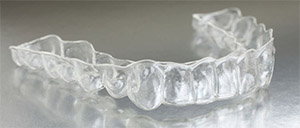 Dentistry has traditionally used plastic appliances (splints and nightguards) to fit over the teeth and protect them from the damaging effects of bruxing (grinding the teeth) and clenching (pressing the teeth). Known as nightguards, splints, and bitegurds, they have been traditionally used while sleeping because much of the damage occurs while sleeping.
Dentistry has traditionally used plastic appliances (splints and nightguards) to fit over the teeth and protect them from the damaging effects of bruxing (grinding the teeth) and clenching (pressing the teeth). Known as nightguards, splints, and bitegurds, they have been traditionally used while sleeping because much of the damage occurs while sleeping.
“Nightguard”s or “splints” are used during the day to help with jaw pain and muscle pain. Daytime parafunction has an association with nervous tics and reactions to stress.
More recently Sleep Bruxism has been reclassified as a movement disorder with links to UARS (upper airway resistance syndrome). Nightguards and splints can potentially mask symptoms of Sleep Breathing Disorders or worsen them. Nighttime bruxing and clenching is no longer appropriate as a reason to make a nightguard.
Dentists such as myself who have specialized in orthopedic TMD disorders and Dental Sleep Medicine, as well as a growing body of researchers. It is important for patients with bruxing and clenching be screened for degenerative TMJ disease and Sleep Disordered Breathing; the primary causes of nighttime bruxing and clenching.
If you have a dental nightguard, splint, or biteguard it is suggested you should be screened for a TMD and/or Sleep Disordered Breathing. An online survey is available on our website for both conditions. If your score suggests a TMD or Sleep Disordered Breathing condition, I recommend a consultation to discuss the results and your options for treatment.
Referenced Dr. David Shirazi, DD. TMD/Orofacial Pain and OSA, Correlation or Causation?
TM Diary, Summer 2016. (publication of Am. Acad. Craniofacial Pain)



